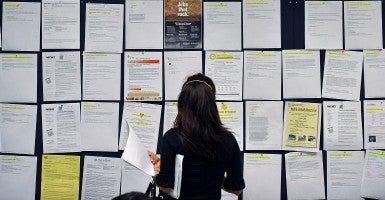The Bureau of Labor Statistics’ November employment report showed solid economic growth, but also provides clues about why many Americans report unhappiness with the economy.
The headline figures contained mostly good news. The household survey reported the unemployment rate remaining flat (5.8 percent) at the lowest rate since July 2008. Labor force participation also remained flat at 62.8 percent as did the employment to population ratio—remaining 59.2 percent, the highest since mid-2009 but well below pre-recession levels.
The average duration of unemployment has remained stubbornly high, rising to 33 weeks in November.
The payroll survey reported employers created 321,000 net new jobs in November—the most in any month since April 2011. The professional and business services (+86,000), retail trade (+50,000), healthcare (+29,000) and food services and drinking places (+27,000) showed the greatest gains. The payroll survey also found the average work hours increasing a tenth of an hour to 34.6 a week—the highest level since early 2008. In more good news, revisions to the September and October surveys showed that employers created 44,000 more jobs those months than previously believed.
Nonetheless, polls suggest that most Americans consider the economy in poor shape. The exit polls from the midterm elections found that 70 percent of voters see America’s economic condition as either “not so good” or “poor.”
Over the past year, average wages have grown by 2.1 percent—only slightly above the rate of inflation.
The November jobs report gives some insight into why. The average duration of unemployment has remained stubbornly high, rising to 33 weeks in November. The median unemployed worker has been looking for work for almost three months—almost twice as long as before the recession hit. Unemployment has become more painful for workers; those who lose their jobs have much greater difficulty finding new ones.
Additionally, average hourly wage growth has slowed to a crawl during the recovery. In November, average wages rose just 9 cents an hour. Over the past year, average wages have grown by 2.1 percent—only slightly above the rate of inflation. Thus, the real buying power of American workers has hardly improved.
This also shows why claims that this represents the strongest economic growth since the tech bubble are misleading. Yes, the economy has added jobs at a good pace – welcome news after the deep recession and anemic recovery. But wages grew far faster and the unemployed found jobs far more quickly in the mid-2000s. This does not feel like a booming economy because it is not.
All told, November’s employment report brought welcome news about labor market improvements—but the economy still remains far from a satisfying recovery.






























